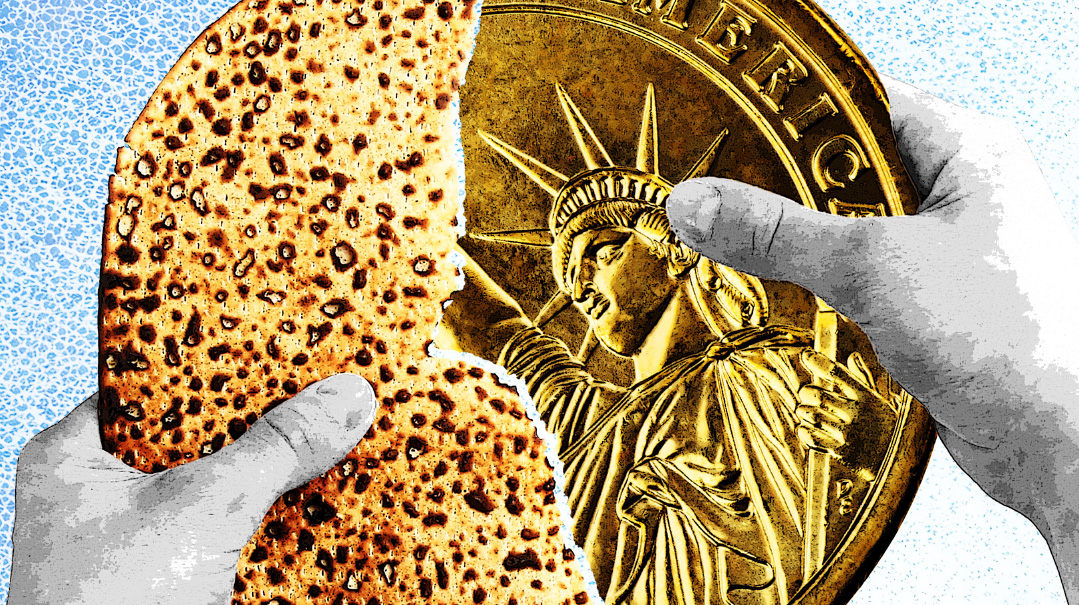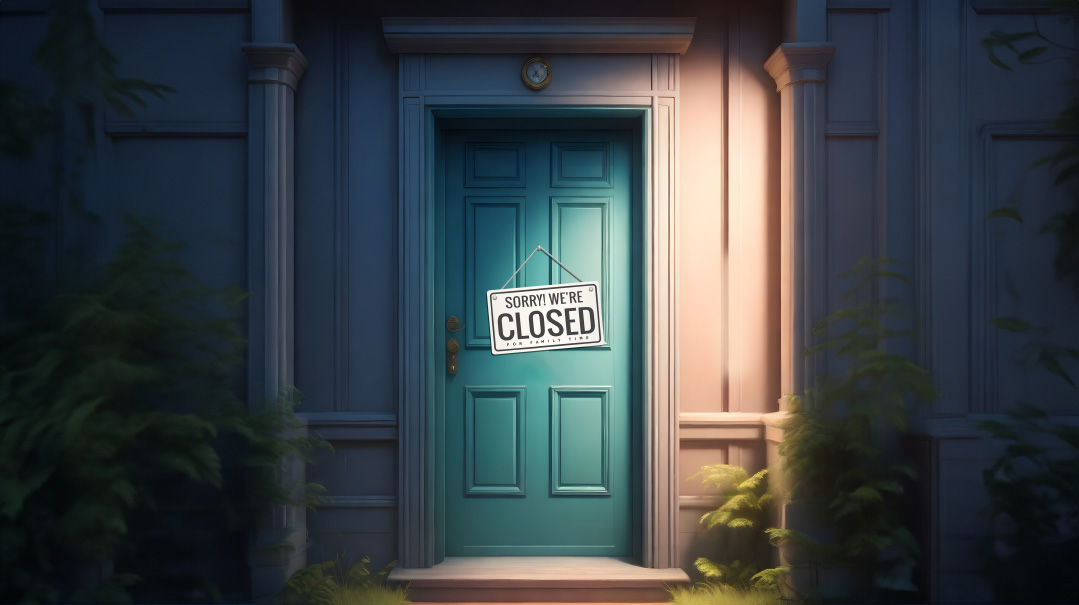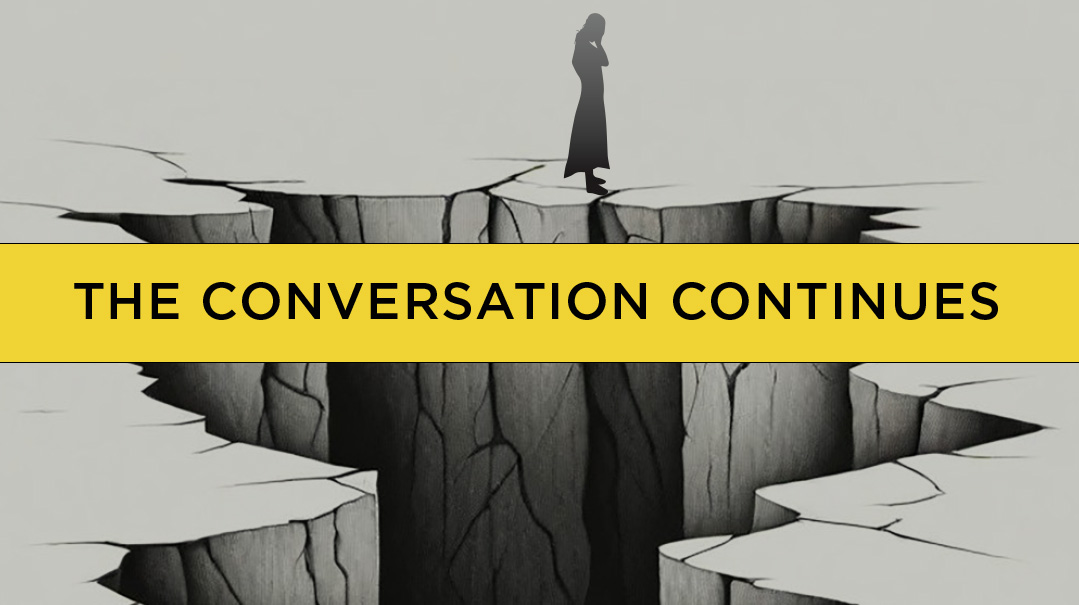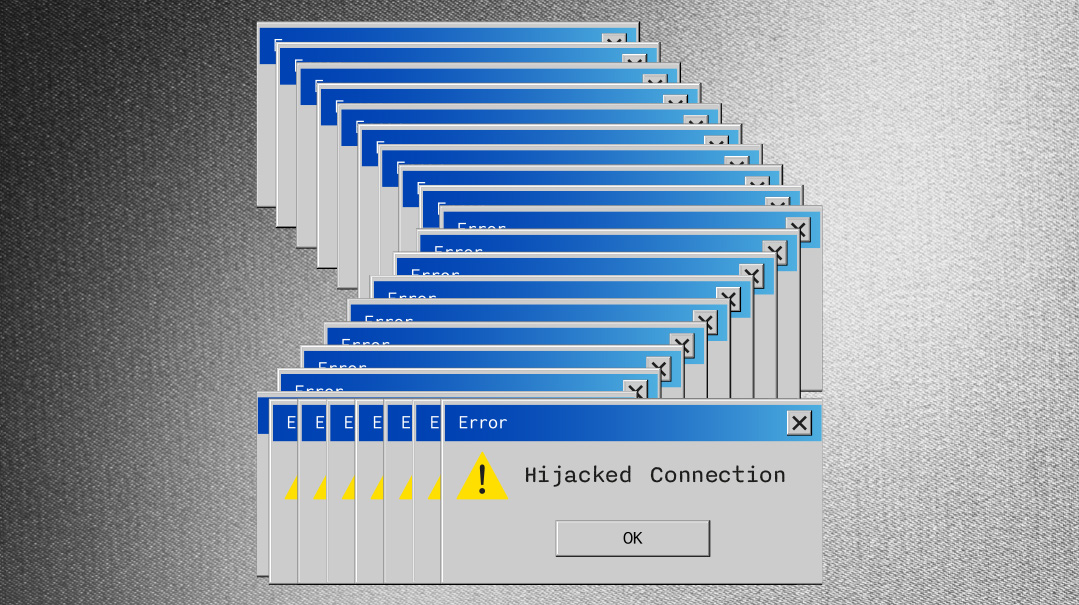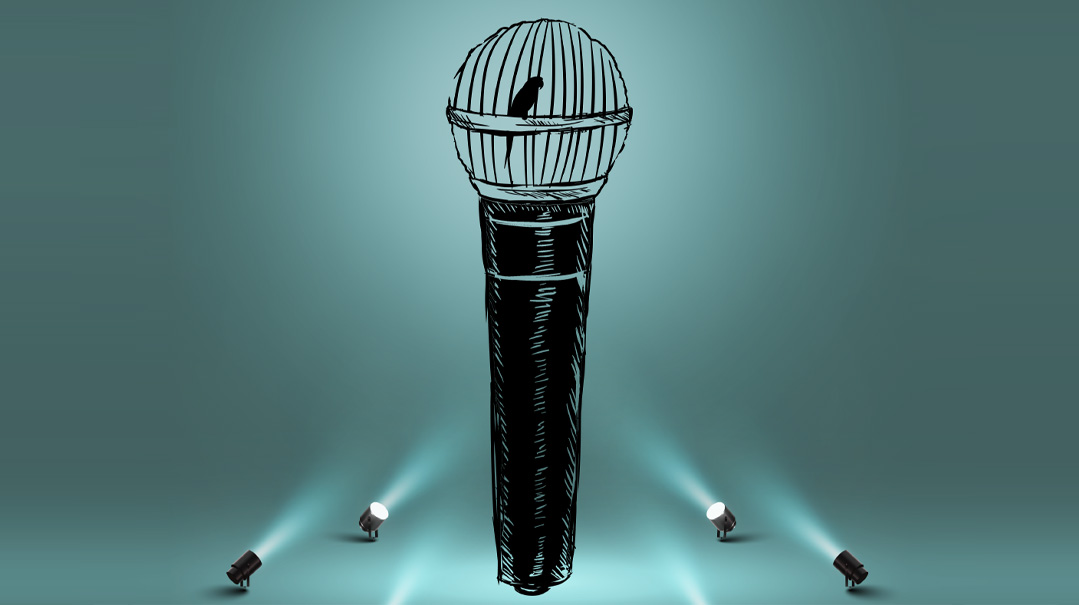Not Black and White
| November 29, 2022Only tough measures could save our shul's crumbling decorum

Levi: We need to maintain certain boundaries to safeguard our shul.
David: I’m here to daven; why are you looking at what I wear on my head?
Levi
You want to know what’s really going on in a shul, speak to the gabbai.
He’s the one who sees the way things are going, when a community is growing, shifting, changing. Trends start small, it’s hard to notice subtle changes, but when you’re looking at the crowd, week in and week out, you get a bigger picture, and often, it tells you a lot.
I’ve been the gabbai at Khal Beis Avrohom for a few years now, and I’ve watched the community grow, the core group of members turning into a respectable size kehillah. We started off as a group of guys in their thirties, though by now the founding members are beginning to marry off their kids, and we have a younger crowd as well — the older members’ sons, some young men from the neighborhood, the avreichim who learn in the kollel that uses our premises.
All in all, it’s a nice, cohesive crowd, serious bnei Torah who are committed to the shul and to the rav. And notably, it’s a shul that displays kavod for tefillah. Rabbi Eisenstein, the rav, has always stressed the importance of not speaking in shul during davening, and the kehillah really adheres to that. It’s a point of pride for the mispallelim that the shul is silent during davening and leining.
Which is why I wasn’t the only one who noticed when some newcomers began joining Friday nights, and — obviously unaware, or perhaps not really caring, about our shul’s careful standards in this area — held animated low-voiced conversations through Kabbalas Shabbos. Several of the mispallelim nearby turned around to shhh in their direction, but it didn’t seem to help at all.
It was hard to miss the newcomers; aside from their running conversation straight through davening, they were also dressed distinctly more casually than the avreichim who made up the shul’s membership; they didn’t wear hats and were dressed in snazzy, fitted suits in varying shades of gray and navy. I asked around a little, tried speaking to some of the guys who were joining the minyan, and pieced together what was happening.
We live in a very broad, diverse community, with Yidden of many streams and backgrounds. Our very serious kollel-style minyan was located on a main thoroughfare, right near a newly developed area with many young families. And although they didn’t belong to our shul, the convenience made it the shul of choice for many of these men to daven on Friday nights.
They seemed to be a chevreh of sorts, the kind my son Chesky called “chillers.” They liked to schmooze, didn’t seem to listen when the rav got up to speak, and were in and out the door without engaging with anyone from the community. They saw the shul as somewhere to daven, get their Minchah-Kabbalas Shabbos-Maariv, and that was all.
And this new development was only getting worse. As more families of that type moved into the area and the chevreh brought their friends, the chatter at the back crept toward the middle of the beis medrash.
One week, things got so out of hand that the Rav stopped in the middle of Kabbalas Shabbos to ask everyone to be quiet. I wasn’t sure if some of the guys even heard, they seemed to be chuckling over some sort of joke. As I scanned the room, hoping the Rav’s words were taking effect, I noticed something disconcerting: many of the regulars’ seats were empty, while over half the mispallelim were the new crowd — who didn’t even belong to the shul.
It could’ve been coincidence — a few of the members could’ve gone away, or davened elsewhere as a one-off. But I suspected it was more than that.
The next week, the shul was noticeably empty again for Friday night davening. Empty of the regulars, that is — the back rows were full. Full, and noisy. It seemed like the “new chevreh” were making themselves comfortable, bringing friends.
Which would have been great — we’re always happy to welcome guests to the shul, or to have new members join — but when it was bringing the entire atmosphere down and alienating the steady mispallelim who had been davening there all along, we had a problem.
With the regular rows half empty, it took me a few minutes to find someone to daven at the amud. While I was scanning the room for someone with a nice voice and preferably a loud one — to overpower the chattering at the back — one of the new guys strolled over. He was wearing a blue shirt, no jacket.
“Hey, what’s taking so long, I’ll daven,” he half-asked, half-stated.
I gave a semi-nod — did I have a choice? — but I had a bad feeling about it.
“Lechu neranenah l’Hashem…” he began. Or at least, I think that’s how he began — it was so fast, I could barely make out the words.
Someone cleared his throat. A few of the regular shul members were looking at me pointedly. I shrugged slightly — what can I do — and turned to focus on my own davening, but inside, I made a firm decision to speak to the Rav this week. We had to do something, something about the talking and the very far from serious atmosphere that was being cultivated; something to stop our Friday night davening turning into a joke or a speed-race to be the fastest minyan in town.
And most importantly, to bring the shul back to the standards we had always kept to. And then, the people who had actually built this shul from nothing would actually feel comfortable davening there again.
The next day, most of the regulars were back. After kiddush, I made my way over to Zalman Katzberg, one of the founding members of the shul, whose absence the night before had been one of the most marked — Zalman never missed a minyan, and was extremely loyal to the shul and the Rav. I had to confirm my suspicions about the growing trend of our members davening elsewhere on Friday night.
“Reb Zalman, we missed you last night,” I said, offering him a l’chayim and hoping I sounded casual. “Found somewhere with better air conditioning?”
“Taking attendance again?” he replied, aiming for a jocular tone. But I noticed that he didn’t meet my eyes.
“No, it’s just that we always notice when our most chashuve members are missing,” I volleyed back.
He shrugged and muttered, “Surprised you could notice anything with the noise that goes on Friday nights.”
Aha. So, it was the issue.
“Zalman, tell me, you’re not davening here Friday nights because of the… new crowd? The talking?” I asked, lowering my voice. “Because I know it’s an issue, but if we want to make change, I need to go to the Rav with information. Numbers. We need more than just me saying that this has to stop.”
Zalman shrugged. “Look, you can tell the Rav… I’m not the only one. We just don’t feel like this is the atmosphere we chose, the standards we want our children to see, and we’ve been going to different shuls on Friday night. This is our shul, our community, but until something changes, we’re going to need to daven somewhere else once a week.”
I waited until mid-week to discuss it with the Rav. This was a serious matter, not something we could talk about al regel achas after the kiddush on Shabbos morning.
“Thank you for bringing this up, Reb Levi,” Rabbi Eisenstein said, his face clouding over. “L’maiseh, we have a problem. We can’t turn people away from shul, but we can’t have them make it uncomfortable for the regular mispallelim either.”
I felt myself getting heated up. “They’re just using the shul, it’s a convenience thing for them,” I said emphatically.
The Rav gestured with his hand, as if to calm me down. “I understand, Reb Levi,” he said. “Look, anyone is welcome to join the shul, but they need to adapt while they’re here. You can let people know that if they’d like to join the minyan, we ask them to respect the shul and its standards.”
“Standards” was a vague word, and it took some discussion to come up with a more substantial plan. But the next Friday night, there was a clear, bold-lettered sign on the door, asking people to only join us for davening if they were committed to davening in the shul regularly, and could adhere to a list of guidelines — first and foremost, not speaking during tefillah. I also included that in order to be “recognized” in the shul, which would allow mispallelim to daven from the amud or receive an aliyah, they would have to dress in accordance with the community’s standards, which meant wearing a hat to the tefillos. Of course, showing respect for the Rav, especially during the derashah, was a must. I figured this would be the simplest way to let people know they had to make a choice: in, all the way, or out.
But it didn’t go down so smoothly.
“Do you mean to say you’re going to stop people coming in to daven?” a short guy with trendy glasses asked me, raising an eyebrow.
“Okay, so we’ll pay membership, that make you happy?” said another, whom I recognized as the son of a well-known philanthropist, with a smirk.
“It’s not the money,” I said. “It’s about a commitment to a shul, and to keeping certain rules that everyone follows as part of the kehillah. If you’d like to be a full part of the shul, to daven at the amud, and so on, we ask you to keep to the standards set here. Respect the community. The Rav. The tefillah. Wearing a hat to shul is a chumrah that we keep, and it makes the atmosphere more formal. There’s more respect for the davening, and it gives the message that shul isn’t just a place to show up and socialize. If you can be part of that, you’re very welcome.”
There was an outburst, many disgruntled comments, and a lot of confusion as the regulars began streaming in for Minchah while a large group of the newcomers gathered at the back to argue with me.
Eventually, Rabbi Eisenstein himself came over to suggest that everyone come inside and daven, and then take the time to think about things before next week. No one seemed too happy with the temporary truce, but they did shuffle inside, and davening began.
I felt a lot of glares in my direction, but I’m a gabbai, it’s part of the territory. I’ve grown a thick skin on the job.
Kabbalas Shabbos was much quieter. I guess people got the message. It was a shame we had to resort to signs like that, but what could we do? It was that or watch our own kehillah crumble.
After davening was over, a few guys cornered me to argue again. I stood my ground, reasserting that this was the Rav’s decision and the shul wasn’t able to accommodate people who wouldn’t stick to its standards. Finally, they left, and several of the community members stopped by me with their take.
“Great move, Levi,” one said.
“To be honest, I was thinking of starting to go somewhere else to daven. I’m so glad someone’s doing something about it,” another told me.
“Yasher koach,” yet another said.
Someone else stepped forward. He looked vaguely familiar — one of the steady Friday night drop-ins.
“You’re the gabbai here? The one who wrote the sign?” he asked.
“Why?” I asked, warily. I’d lost patience already, was absolutely not in the mood for yet another confrontation.
“Look, I like to come here,” he said, somewhat haltingly, I thought. “I enjoy the davening. I have a lot of respect for the shul, the community, and the rabbi. Next week, I have yahrtzeit, I was hoping to daven from the amud, since this is where I daven every week… But I just don’t understand the caveat about the dress code. It’s not enough to be wearing a Shabbos suit?”
I took in his dress in a glance; knitted yarmulke, blue shirt, and neat suit trousers. He seemed like a nice guy, respectful and mild-mannered. He probably wasn’t one of the talkers. And he looked genuinely confused about why his clothing had anything to do with where he davened. But we had created guidelines to raise the level of the minyan, and it was simply impossible to make an exception just now — right when we’d said a firm “no” to everyone else.
“I’m sorry,” I told him, and I meant it. “I would be happy to give you the amud next week, but like it said on the sign, the Rav has given certain guidelines… and davening with a hat is one of them.”
A look passed over his face: incredulity, confusion, and a deep hurt.
“I’m sorry,” I repeated. I felt bad for his pain, I really did, but what could I do?
If I could tell David one thing, it would be: We have to set certain boundaries to safeguard our community’s standards, and now, when we’re struggling to implement them, we can’t afford to make an exception.
David
I’M going to put it out there, even though it’s not something people are usually comfortable to admit.
I find it hard to daven in shul.
I’m sure I’m not the only one. I didn’t learn Hebrew very well as a kid, so I struggle to understand the words. I also don’t read that well, which is embarrassing at my age. The prayers can be long and tedious, or at times, go so fast I can barely keep up. Special days are marked by special (and extra-long) tefillos, which can take several hours. And honestly, I didn’t have the best experience in shul as a child, so the whole thing is really not easy for me.
Still, I try. And over the years, I’ve figured out how to make it work. Which shuls have a pleasant atmosphere, some nice singing, where they don’t rush too much but don’t drag things out either. I daven Shacharis at haneitz, Minchah at a minyan near the office, and one Shabbos a few months back, a couple of friends recommended that I join them at a small shul not too far from my house, where the atmosphere was serious but pleasant, and they davened at a good pace. There was plenty of space, the people seemed nice, and I quickly settled into the habit of going there for Friday night, sometimes Shabbos morning as well. My friends didn’t usually daven there in the daytime, but it wasn’t like I belonged to another shul. Besides, what I liked about the shul was how serious it was — and I got the feeling that my friends weren’t so into serious when it came to shul. For them, it was kind of a social event, the chance to catch up on the week’s news. When they got involved in heated conversation, I usually just moved over a little. It was hard enough to focus and keep up without having to juggle conversation as well — and besides, I didn’t think it was the right time and place to socialize.
My wife was happy with the shul that I chose to daven in, pleased that I’d “found my niche,” as she liked to call it. It wasn’t much of a niche, nor was it really “mine” — I wasn’t a real member of the shul, and their lifestyle was clearly different than mine and Lori’s — but it was nice to have somewhere familiar, pleasant, and reasonably fast-paced for Friday nights. The crowd was definitely very yeshivish, but they were also nice; the kind of people you couldn’t get intimidated by because they were just overall pleasant and unassuming. The rabbi seemed like a genuinely good person, warm and thoughtful and intelligent, although his speeches often veered into unfamiliar territory — complex Gemaras, lots of Aramaic quotes. Still, they always had a strong message, and although I never actually did go over to speak to him, I felt like I could, which was nice.
I got to know a couple of the shul members, the ones who sat near my “regular” seat in the back row. It was easy to tell who belonged to the shul, and who was just there for the Friday night minyan — the community itself was a real yeshivah-style place, full of kollel men in black hats and suits, while my friends and I were quickly joined by others, who came to enjoy the tefillos, that belonged to “all types and stripes” of Orthodoxy, as they say. It was interesting to see that I wasn’t the only one attracted to this small but warm community.
At some point, the atmosphere started changing.
When I’d begun frequenting the minyan, one thing that had impressed me was the utter silence during tefillos. The community was scrupulous about their davening, and no one spoke to each other until the tefillah was over. It was something I appreciated, and it definitely helped my concentration.
Slowly, though, that began to change. It started, unfortunately, with some of my friends. Like I said, they liked to catch up; they saw shul as a great opportunity to socialize after an intense week. When it was just three or four of them, the talking remained a slight background hum. But once the crowd of non-regulars swelled to fill a few rows, the hum grew louder. Eventually, the under-their-breath quick schmooze morphed into full-fledged conversations and debates, straight through Kabbalas Shabbos, and even Maariv. Every so often a guy with a long, reddish beard — the gabbai, I think — would shhh them loudly, giving pointed stares at the noisiest offenders, but it wasn’t too effective.
At one point, the rabbi himself stepped in and requested that everyone remain quiet for the duration of the tefillah. It helped a little — but not for long. I decided to move to a different seat, nearer the front, to stop myself from getting distracted, and so that I could enjoy the davening again. It was better, but only a little.
I had an interesting vantage point, observing the community as an outsider, and over time I felt something shifting in the Friday night minyan: the “old crowd” was getting more and more frustrated, as more and more non-members started frequenting the shul on Friday nights. Apparently, it was becoming the place to be: well-paced davening, good location, and great company (with, apparently, highly interesting conversation to boot).
Some of the regulars stopped coming. There was a young guy, Yaakov something, who I’d spoken to a few times; I hadn’t seen him in a while. And the row I liked to sit in was half-empty, although I knew that most seats belonged to paying members.
I guess they weren’t enjoying the new Friday night atmosphere that much.
Still, I kept coming. I was used to it, it was comfortable, and if I tuned out the chatter in the back, I still enjoyed the style of davening from the front of the room. That was the main thing, wasn’t it?
And then my father’s yahrtzeit came around.
Davening from the amud is always a huge struggle for me. I get self-conscious and very nervous, and that doesn’t help my fluency at all. Every year, I start worrying weeks in advance about where I’m going to daven from the amud, which shul would have a small crowd, where I’d feel comfortable, and where they would allow me to daven from the amud without any issues.
This year, since the yahrtzeit fell out on a Friday, I planned to daven Minchah at my “Friday night” shul. I felt comfortable there, and knew that the regular crowd would be patient and accommodating. It had been something of a relief as the date approached, knowing that for once, I had a plan in place, somewhere I felt confident and comfortable to daven from the amud — or at least as confident and comfortable as I could, under the circumstances.
And then, one week before the day, I came to shul to find an uproar going on near the door.
“Is this some kind of new fundraising idea?” someone was asking, too loudly. “They want us to pay or something?”
The red-bearded gabbai was in the middle, trying to talk over the crowd. He kept gesturing towards a large sign near the door and shrugging, as if to say, this isn’t my fault.
I edged close enough to read the sign. In large, bold print, it stated, “By request of the Rav, we would like to make you aware of the following guidelines:”
There was a lot of smaller print below, but it was hard to get close enough to read it all. I caught a glimpse of the word “respect” and something about wearing a hat. Then there was a Hebrew quote in bold, followed by the words, “No talking during davening or leining!!” And then, the clincher: “In order to be able to receive an aliyah, daven from the amud, etc., we request that these guidelines be followed at all times.”
Wham.
It was a punch in the gut.
I knew that the sign wasn’t intentionally directed at me — it was clearly an attempt to regain the decorum and have the “old crowd” comfortable to come back again. But I was still uncomfortable, especially when it sounded like they were differentiating between people based on whether they wore a black hat or not. Yes, the community members all dressed in the standard yeshivah “black and white,” with the black hats to boot. But was that really a reason to exclude someone? Why should what I wear on my head make a difference to whether I was “recognized” as part of the shul? We weren’t talking about anything offensive. I wore a yarmulke. They wore hats. What was wrong with that?
I looked down, feeling suddenly self-conscious. For how long had I attended shul here, thinking I’d finally found a home, when actually I was being noted, judged, and rejected for not wearing a hat?! Something stabbed at my heart, and I almost turned around and left.
In the back of my mind, where I could think logically about it, I knew no one meant to single me out at all. The shul cared about decorum, about respect for prayer, and the crowd it had been attracting recently clearly didn’t have those same values. I could understand them for trying to make some rules about who could join the tefillos. But to label all those who didn’t dress like them as “outsiders”? How could that be okay?
Calm down. It’s probably just a way of trying to filter out the ones who aren’t serious about shul, I told myself. After Maariv, when things settle down a little, I’ll speak to the gabbai, work things out. I’m sure I’ll be able to daven from the amud for the yahrtzeit, he’ll understand. It’s just a hat.
It seems I wasn’t the only one who was upset at the idea of being excluded from the privileges that being a member of a shul involves. A few of my friends were out in the hallway, loudly informing the gabbai that he had no right to insist on anyone wearing anything, and that nowhere in the Torah did it state that one must wear a hat to receive an aliyah in shul. He kept shrugging and pointing to the sign, talking in a voice that was too low for me to hear over the noise.
The argument was getting too intense for my liking when the Rabbi came over and put a stop to the discussion. He suggested that just for this week, everyone who was already in shul could join the tefillos, and for the following week, anyone who returned would be expected to adhere to the guidelines. That was smart, I thought — let people go home, get over it, and find another place to daven next week. I was looking forward to the quiet, reverent tefillah that I remembered from when I began attending the minyan.
After davening, I tried approaching the gabbai. It was easier said than done, since many people were still trying to make their voice heard and speak up against the sign he’d put up. I heard the word “discrimination” many times, and while I tried not to agree with them, I couldn’t help but think that distributing privileges based on externals was really a pretty discriminatory thing to do.
Finally, when the shul was mostly empty, I got to speak to him.
“Hi, I’m David,” I said, offering my hand for a handshake. “You’re the gabbai, right? The one who put up the sign outside…”
“Why?” he asked. I was slightly taken aback at the brusque tone, but I guessed he’d had a hard evening.
I explained that I enjoyed the davening and had been attending shul Friday night for a while, but since I had yahrtzeit coming up, I wanted to clarify the terms of the sign. “You probably recognize me, I’ve been here a couple months, I’ve been sitting near the front…”
He nodded distractedly, and I hoped he understood what I was trying to say: My friends might have been causing disturbance to the tefillos, but I’d never been a part of that; I wasn’t there to bother anyone. I was simply trying to daven. “And now that I see there are some rules about who can and can’t daven from the amud, I wanted to check in about Minchah next Friday…”
The gabbai’s eyes traveled over me. Why was he eyeballing me like that? Discomfort rose in my stomach.
“I’m sorry,” he said, finally. “The shul… we have certain standards, I’m sure you saw on the notice…”
I waited. What was he going to do — tell me I had to wear a black hat? Surely he could hear for himself how ridiculous that would sound.
He didn’t respond, and the silence stretched. “I’m not sure what you mean,” I finally told him.
Now he looked even more uncomfortable than I felt. “I’m sorry,” he said finally. “I would love to give you the amud, but the Rav has… you know, like the sign said. There are guidelines… and davening with a hat is one of them.” He gestured toward the front.
I turned and walked away from the gabbai, reeling. I had nothing to say. On my way out of shul, though, my eyes were drawn to the sign.
The guidelines that congregants were asked to follow were pretty obvious at first: respect for the shul, the rabbi, the community. Not to talk during davening or Torah reading. During the week, to have all phones switched off or on silent mode. But then there were others, too. Not to bring smartphones into the shul. Not to congregate in the corridor during the Rabbi’s speech. To wear a hat during davening.
I had no problem with any of the rules — it was Shabbos anyway; my phone would always be at home. Except for the last. I don’t even own a black hat, and I certainly wasn’t buying one just to join a minyan. I did have a straw hat that I wore occasionally in the summer, but even I knew that it wasn’t what they meant with their talk about standards and “dress code.”
I looked down at my Shabbos suit and crisp shirt. So, it wasn’t white. So, I wore a knitted yarmulke instead of a black velvet one topped by a Borsalino. Did that make me any less of a religious Jew? Was that the reason I was being excluded from the minyan?
The gabbai passed by, eyes darting away from the sign. “I’m sorry,” he muttered as he passed. I tried to muster up some understanding, but I couldn’t.
Asking people to respect the shul, to keep quiet during davening, to listen to the rabbi — that’s well within their rights as a community. But how could they define people by looking at what they wear?
If I could tell Levi one thing, it would be: I’m a Jew, just like you, who simply wants to daven. How can you turn me away because of something as superficial as a hat?
(Originally featured in Mishpacha, Issue 938)
Oops! We could not locate your form.
